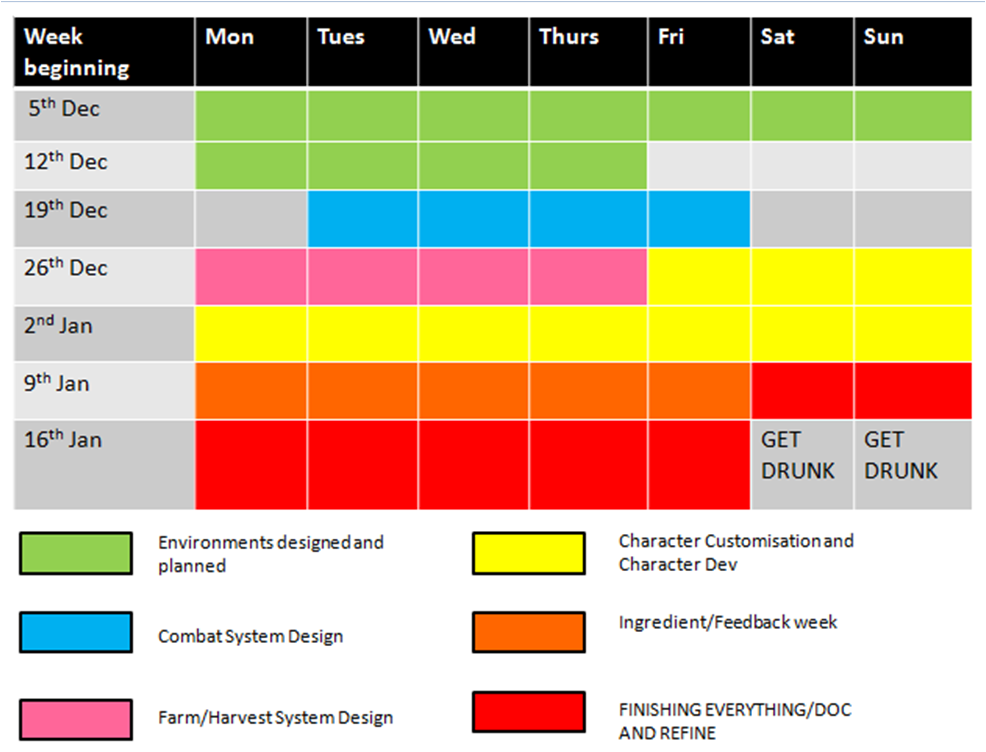Crafting and Harvesting System – Team Meeting/Discussion
We needed to focus on looking into the Crafting and Harvesting systems in a backwards manner in order to figure out what ingredients we would need. This came to light when I was planning my tasks over the next few weeks and found that in order to complete the systems given to me, I need to know what’s going in them first. To start off with, we collectively decided to keep the number of dream potions to a maximum of ten for alpha build as otherwise the game will grow to be more and more complicated and we need to make sure we keep it sweet and simple for now; this will give us a better advantage in trying to get our game to Steam Greenlight if it’s simple and polished rather than rushed and overcomplicated.

We mapped out from finish to start what the ten dream potions (in Orange) would be and what sorts of ingredients they would be made up of (see far right of image). We based this off of intuition, for instance, Lavender and Chamomile are often items associated with sleep and therefore we have selected those as possible ingredients for forming the sleep potion. It would be nice for the game itself to make sense and potentially teach the players about gardening/farming through the use of ingredients. This will be something that I’ll be working on when I come to work on the Farming and Harvesting systems and will also be part of the next steps section in the GDD.
The ten potions will be grouped into threes except for the Time Travelling potion. This means that potions in the same group with have the same framework and will need the same ingredients yet the special ingredient from Dungeoneering will determine the outcome of potion. This’ll be something that I’ll be needing to work out later on when I come to working on the Farming and Harvesting Systems.
As discussed with the team, I will need to consider the number of plots that will be accessible to the player at once as it can’t be a “grow everything at once” game – you’ll have to plan strategically. There will also be things to consider such as some plants may be more difficult to grow or have certain demands where say one plant may not be able to grow next to another etc. We’ll be able to alleviate the difficulty through the use of Perks when you level up your character.
Once I start looking into the ingredients, I’ll be able to work out how the Farming and Harvesting Systems could work so this will have to be on hold for now, however, we know that they harvesting system would act as a mini-game. For example, in order to produce a Flying, Quest or Travelling potion, you would need to plant Peppermint, Pine and Ginseng; harvesting them would be a mini-game as this will help to determine the quality of the ingredients (how you looked after them and how well you did in the mini-game).
Once you’ve harvested these starter ingredients, the player would then need to go Dungeoneering in order to get the ‘special ingredient’ that combines with the starters. The special ingredients will be found on different levels in the Dungeon and the amount you find each time will differentiate every time you visit. This meaning you may have to visit the Dungeon more than once in order to obtain the special ingredient you need or travel deeper inside to find more; James is working on the Dungeoneering environment experience and the special ingredients are later on.
The goal for us at the end of Semester Two is to have an Alpha Build ready to release for Steam Greenlight. For the purposes of this, we will be keeping the Time Travelling Potion hidden from the player and so they have to figure out what combinations of ingredients are needed to make this desired potion. It may also be an idea that you can only make this potion with the right ingredients if you achieve a near perfect score in the mini-games, therefore challenging the target audience.
Now we’ve expanded on this, I feel a lot more confident in going forward to create the Farming and Harvesting Systems. This will be occurring from the 19th – 22nd December but at least now I have all the key information I need to proceed which is helpful.









